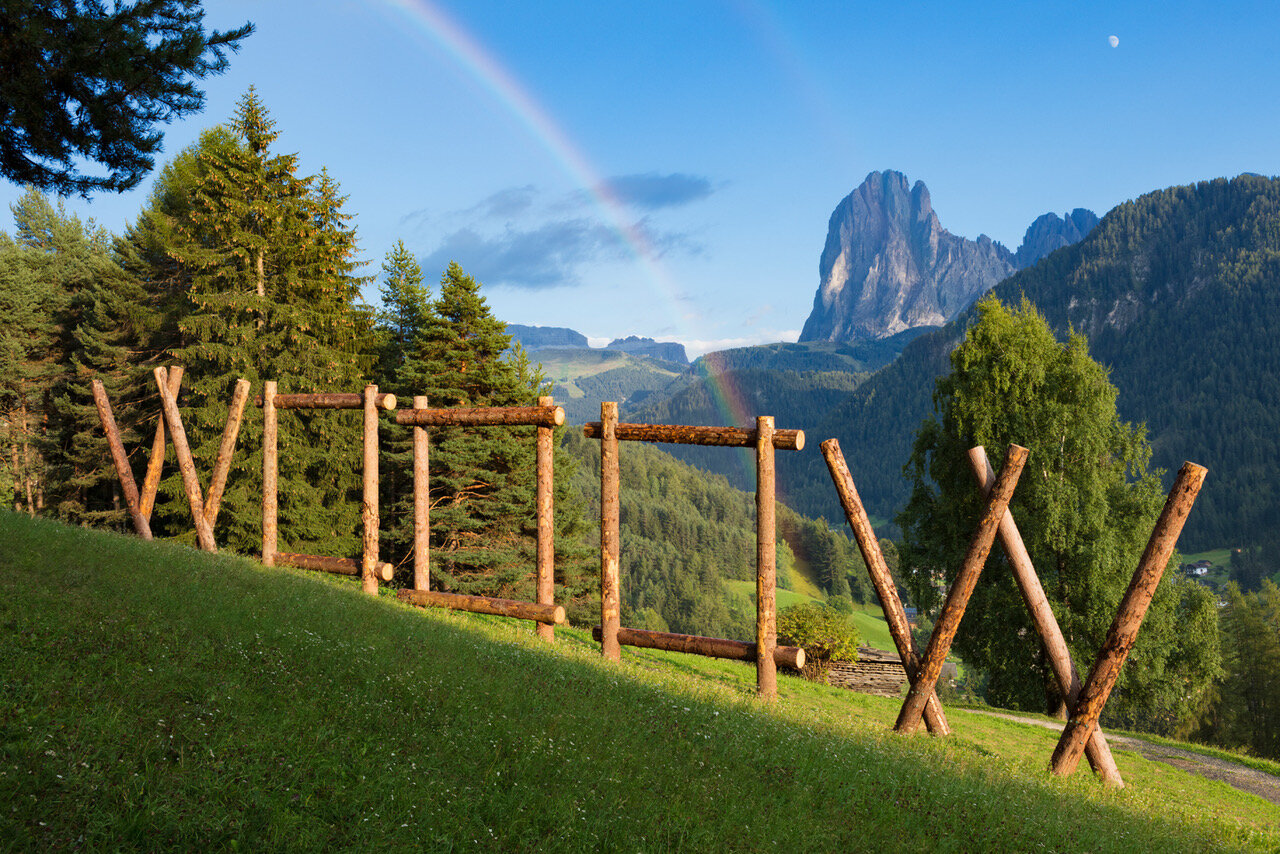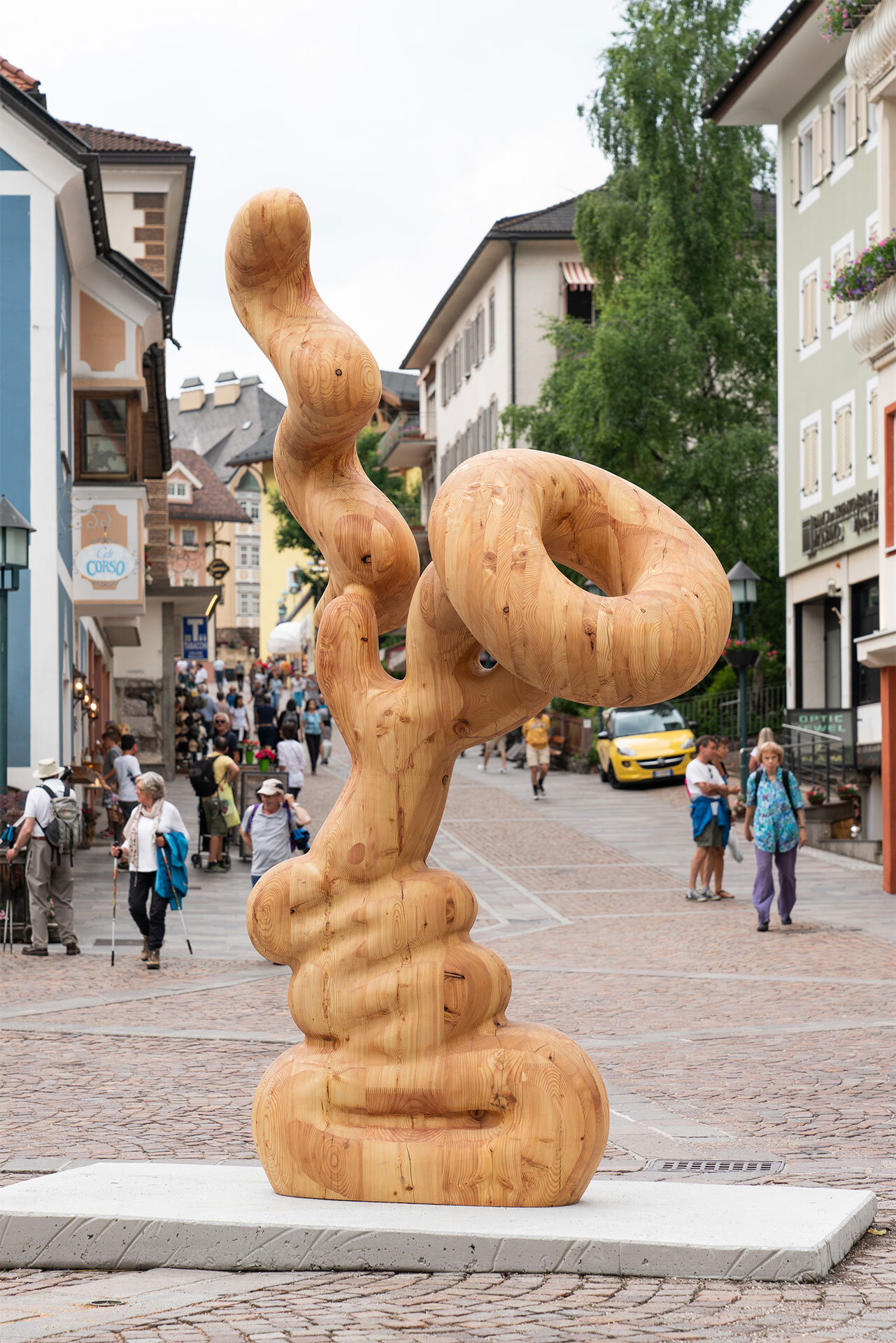
Claudia Comte
*1983,Switzerland
lives and works in Grancy, Switzerland and Berlin, Germany
EN
Comte’s new work for the Biennale Gherdeina is a tour de force of sculptural gesture in regards to its scale and conceptual ambition - a pure expression of precision, radicality as well as a humor Comte just talked about…The artist considers the Dolomites’ mountainous hills as a blackboard where the palindromic WOOOW is spelled out with its boldness and grandiosity by 20 spruce trunks each 6m high. But WOOOW is not only a palindrome, it is also an onomatopoeia, meaning the word can be read with a particular sound in mind, a sound, enhanced by its picturesque surroundings, conjuring sentiments of reverence and awe. WOOOW holds no hierarchy of viewship, it can be read from all orientations, forwards and backwards, in this regard the work’s form of address can be thought of as democratic or egalitarian. WOOOW truly amazes by its monumentality and an accurate site-specificity as it constitutes a sincere tribute to the picturesque landscape of Sassolungo and its sublime quality, evoking both endurance and resilience, and praising the mountains as a site of awe and intimacy. The cyclicality of its utterance forever echoes over the hill tops, with humour and self-reflexiveness, we might wonder whether the sculpture is asking it’s reader to ruminate on what the natural world might be telling us.
The new work of Claudia Comte, conceived for the Biennale Gherdëina VI, Morphing Sculpture 1: Donut, Cactus and Snake (Viscosity Range), is a totemic collection of forms, a polyphonic assemblage of shapes, interacting one with another in a seemingly uncontrolled way, a formal carnival of sorts… Comte’s is both - an unconstrained joy of making art as well as an attempt to rethink the relationship between the human being and technology, between the man-made and natural materials. Each work is a study on the nature of transformation and metamorphosis. Comte investigates the properties of the materials, their physicality, as well as their magical properties; wood is her favorite medium in conversing with the nature and the universal reservoir of forms. “But with the wood, you have to take time and be gentle, because it cracks. You cannot push it”, the artist explains, “My fascination with wood is simply that it represents the biggest resource worldwide, it’s a material that was here long before us. Its artisanal quality suggests a counter trend and thus it’s so interesting for me to use. This material grows so slowly in comparison to the speed we communicate and do things today in our digital age. It’s heavy in essence and I am trying to make something precise, radical, and humorous out of it.”
IT
La nuova opera nuova realizzata da Claudia Comte per la Biennale Gherdëina è un tour de force di gestualità scultorea sia per la sue dimensioni sia per la sua ambizione concettuale, espressione pura della precisione, della radicalità a dello spirito di cui parla l’artista. Comte, infatti, vede le Dolomiti come una lavagna sulla quale si scandisce, con audacia e grandiosità, la palindrome WOOOW con 20 tronchi di abete rosso, tutti alti 6 metri. WOOOW, che ci sorprende davvero per la sua monumentalità e territorialità, rappresenta un sincero omaggio al paesaggio, pittoresco e sublime, di Sasso Lungo, riuscendo a richiamare qualità come la durevolezza e la resilienza e, nello stesso tempo, a esaltare la montagna come luogo di meraviglia e intimità.
L’opera nuova di Claudia Comte, concepita per la Biennale Gherdëina VI, Morphing Sculpture 1: Donut, Cactus and Snake (Viscosity Range), è una collezione totemica di forme, un assemblaggio polifonico di sagome, che interagiscono in modo apparentemente incontrollato in una sorta di carnevale formale. Emerge sia la gioia sfrenata di fare arte sia un tentativo di ripensare il rapporto tra l’essere umano e la tecnologia, tra i materiali sintetici e quelli naturali. Ogni opera è uno studio della natura della trasformazione e della metamorfosi. Comte indaga la proprietà dei materiali, la loro fisicità e le loro proprietà magiche. Il suo mezzo preferito per dialogare con la natura e il serbatoio universale della forma è il legno. «Ma con il legno – spiega – devi concederti del tempo e devi essere gentile con esso, altrimenti si rompe. La mia fascinazione per il legno deriva semplicemente dal fatto che rappresenta la risorsa più diffusa del mondo e che era qui molto prima di noi. Le sue qualità artigianali richiamano una controtendenza ed è per questo che mi interessa usarlo. Si tratta di un materiale che cresce lentamente rispetto alla velocità con cui comunichiamo e facciamo le cose nell’era digitale odierna. In essenza, si tratta di una materia difficile con la quale io cerco di ottenere qualcosa di concreto, radicale e divertente».
DE
Claudia Comtes neue Arbeit für die Biennale Gherdëina ist eine tour de force an skulpturaler Geste in Sachen Größe und konzeptueller Ambition: ein reiner Ausdruck an Präzision und Radikalität und zugleich des Humors, von dem Comte spricht. Die Künstlerin sieht die Dolomiten als Tafel, an die kühn und prunkvoll aus 20 jeweils sechs Meter hohen Kieferstämmen das palindromische WOOOW buchstabiert wird. WOOOW beeindruckt mit seiner Monumentalität und seiner Ortsbezogenheit als eine ehrliche Würdigung der malerischen und erhabenen Landschaft des Langkofels. Das Werk suggeriert Dauerhaftigkeit und Widerstandsfähigkeit und lobt die Berge als einen Ort der Ehrfurcht und der Intimität.
Die neue Arbeit Morphing Sculpture 1: Donut, Cactus and Snake (Viscosity Range), die Claudia Comte für die Biennale Gherdëina VI geschaffen hat, ist eine totemische Formensammlung, eine polyphone Ansammlung von Formen, die miteinander auf scheinbar unkontrollierte Art interagieren, eine Art Karneval der Formen. Comte drückt beides aus: sowohl die uneingeschränkte Freude über das Schaffen von Kunst als auch einen Versuch, die Beziehung zwischen Menschen und Technologien, zwischen handgemachten und natürlichen Materialien neu zu denken.
Jede Arbeit ist eine Studie über die Art der Transformation und der Metamorphose. Comte erforscht die Beschaffenheit von Materialien, ihre Körperlichkeit und ihre magischen Eigenschaften. Holz ist ihr liebstes Medium für den Dialog mit der Natur und dem universellen Reservoir der Formen. „Doch mit Holz“, so erklärt sie, „muss man sich Zeit nehmen und vorsichtig sein, denn es kann brechen. Man kann es nicht drängen. Ich finde Holz deshalb so faszinierend, weil es ganz einfach die größte Ressource der Welt darstellt, und weil es ein Material ist, das lange vor uns hier war. Seine Entstehung impliziert eine Gegenbewegung, deshalb ist es für mich so interessant, es zu benutzen. Dieses Material wächst so langsam im Vergleich zu dem Tempo, in dem wir heute kommunizieren und Dinge erledigen. Es ist zumeist schwer. Ich versuche, etwas Konkretes, Radikales und Humorvolles daraus zu schaffen.“



